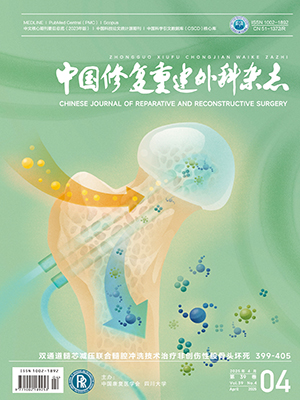| 1. |
Tam RY, Fuehrmann T, Mitrousis N, et al. Regenerative therapies for central nervous system diseases: a biomaterials approach. Neuropsychopharmacology, 2014, 39(1): 169-188.
|
| 2. |
Feng N, Hao G, Yang F, et al. Transplantation of mesenchymal stem cells promotes the functional recovery of the central nervous system following cerebral ischemia by inhibiting myelin-associated inhibitor expression and neural apoptosis. Exp Ther Med, 2016, 11(5): 1595-1600.
|
| 3. |
Long Q, Hei Y, Luo Q, et al. BMSCs transplantation improves cognitive impairment via up-regulation of hippocampal GABAergic system in a rat model of chronic cerebral hypoperfusion. Neuroscience, 2015, 311: 464-473.
|
| 4. |
Guan J, Zhu Z, Zhao RC, et al. Transplantation of human mesenchymal stem cells loaded on collagen scaffolds for the treatment of traumatic brain injury in rats. Biomaterials, 2013, 34(24): 5937-5946.
|
| 5. |
Dimmeler S, Ding S, Rando TA, et al. Translational strategies and challenges in regenerative medicine. Nat Med, 2014, 20(8): 814-821.
|
| 6. |
Ding L, Li X, Sun H, et al. Transplantation of bone marrow mesenchymal stem cells on collagen scaffolds for the functional regeneration of injured rat uterus. Biomaterials, 2014, 35(18): 4888-4900.
|
| 7. |
Taghiabadi E, Nasri S, Shafieyan S, et al. Fabrication and characterization of spongy denuded amniotic membrane based scaffold for tissue engineering. Cell J, 2015, 16(4): 476-487.
|
| 8. |
Li X, Xiao Z, Han J, et al. Promotion of neuronal differentiation of neural progenitor cells by using EGFR antibody functionalized collagen scaffolds for spinal cord injury repair. Biomaterials, 2013, 34(21): 5107-5116.
|
| 9. |
Guan Z, Jia S, Zhu Z, et al. Facile and rapid generation of large-scale microcollagen gel array for long-term single-cell 3D culture and cell proliferation heterogeneity analysis. Anal Chem, 2014, 86(5): 2789-2797.
|
| 10. |
Mahmood A, Wu H, Qu C, et al. Effects of treating traumatic brain injury with collagen scaffolds and human bone marrow stromal cells on sprouting of corticospinal tract axons into the denervated side of the spinal cord. J Neurosurg, 2013, 118(2): 381-389.
|
| 11. |
Cholas R, Hsu HP, Spector M. Collagen scaffolds incorporating select therapeutic agents to facilitate a reparative response in a standardized hemiresection defect in the rat spinal cord. Tissue Eng Part A, 2012, 18(19-20): 2158-2172.
|
| 12. |
Dimmeler S, Ding S, Rando TA, et al. Translational strategies and challenges in regenerative medicine. Nat Med, 2014, 20(8): 814-821.
|
| 13. |
Delcroix GJ, Schiller PC, Benoit JP, et al. Adult cell therapy for brain neuronal damages and the role of tissue engineering. Biomaterials, 2010, 31(8): 2105-2120.
|
| 14. |
Forraz N, Wright KE, Jurga M, et al. Experimental therapies for repair of the central nervous system: stem cells and tissue engineering. J Tissue Eng Regen Med, 2013, 7(7): 523-536.
|
| 15. |
Khatiwala CB, Kim PD, Peyton SR, et al. ECM compliance regulates osteogenesis by influencing MAPK signaling downstream of RhoA and ROCK. J Bone Miner Res, 2009, 24(5): 886-898.
|
| 16. |
Inoue Y, Tsuda S, Nakagawa K, et al. Modeling myosin-dependent rearrangement and force generation in an actomyosin network. J Theor Biol, 2011, 281(1): 65-73.
|
| 17. |
Han S, Zhao Y, Xiao Z, et al. The three-dimensional collagen scaffold improves the stemness of rat bone marrow mesenchymal stem cells. J Genet Genomics, 2012, 39(12): 633-641.
|
| 18. |
Qu C, Mahmood A, Liu XS, et al. The treatment of TBI with human marrow stromal cells impregnated into collagen scaffold: functional outcome and gene expression profile. Brain Res, 2011, 1371: 129-139.
|
| 19. |
Qu C, Xiong Y, Mahmood A, et al. Treatment of traumatic brain injury in mice with bone marrow stromal cell-impregnated collagen scaffolds. J Neurosurg, 2009, 111(4): 658-665.
|
| 20. |
Mahmood A, Wu H, Qu C, et al. Suppression of neurocan and enhancement of axonal density in rats after treatment of traumatic brain injury with scaffolds impregnated with bone marrow stromal cells. J Neurosurg, 2014, 120(5): 1147-1155.
|
| 21. |
Mahmood A, Wu H, Qu C, et al. Down-regulation of Nogo-A by collagen scaffolds impregnated with bone marrow stromal cell treatment after traumatic brain injury promotes axonal regeneration in rats. Brain Res, 2014, 1542: 41-48.
|
| 22. |
Cholas R, Hsu HP, Spector M. Collagen scaffolds incorporating select therapeutic agents to facilitate a reparative response in a standardized hemiresection defect in the rat spinal cord. Tissue Eng Part A, 2012, 18(19-20): 2158-2172.
|
| 23. |
Engler AJ, Sen S, Sweeney HL, et al. Matrix elasticity directs stem cell lineage specification. Cell, 2006, 126(4): 677-689.
|
| 24. |
Lutolf MP, Gilbert PM, Blau HM. Designing materials to direct stem-cell fate. Nature, 2009, 462(7272): 433-441.
|
| 25. |
Ding L, Li X, Sun H, et al. Transplantation of bone marrow mesenchymal stem cells on collagen scaffolds for the functional regeneration of injured rat uterus. Biomaterials, 2014, 35(18): 4888-4900.
|
| 26. |
Anitua E, Prado R, Orive G. Endogenous morphogens and fibrin bioscaffolds for stem cell therapeutics. Trends Biotechnol, 2013, 31(6): 364-374.
|
| 27. |
Steinberg GK, Kondziolka D, Wechsler LR, et al. Clinical Outcomes of Transplanted Modified Bone Marrow-Derived Mesenchymal Stem Cells in Stroke: A Phase 1/2a Study. Stroke, 2016, 47(7): 1817-1824.
|




